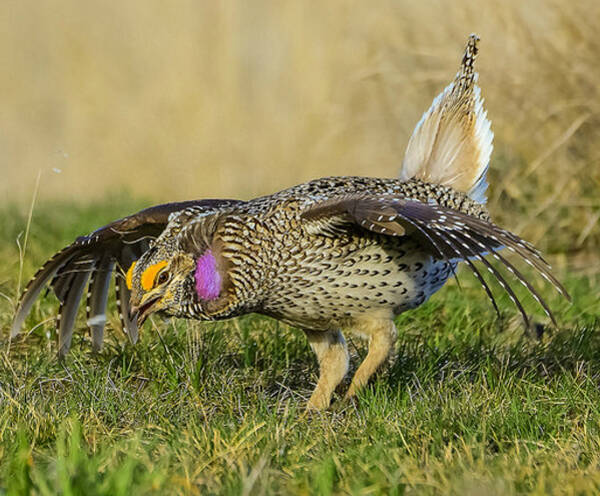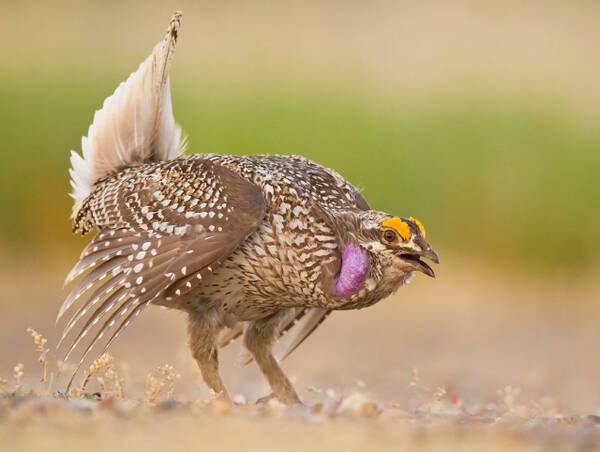Tympanuchus phasianellus
IUCN
LCBasic Information
Scientific classification
- name:Tympanuchus phasianellus
- Scientific Name:Tympanuchus phasianellus,Sharp-tailed Grouse
- Outline:Landfowl
- Family:Gallinomorpha G.family P.Genus
Vital signs
- length:41-47cm
- Weight:815-950g
- lifetime:About 5 years
Feature
The tail is short but has a slender central plumage, giving the tail a sharp appearance
Distribution and Habitat
It once spread throughout much of North America and the North, from southern Alaska through western Canada and south to Nevada and California. Although their numbers are greatly reduced in the East and south, the sharp-tailed prairie grouse can still live in Alaska and central Canada, south to Montana, North Dakota, Wyoming, and Colorado, and also occur in Wisconsin and Minnesota.
Habitats include grassland, scrub grassland, mixed forest areas of shrubs or small forests. With seasonal and habitat changes: in the summer, the sharp-tailed prairie grouse frequented open grasslands, and in the winter, it moved in more closed, higher forest areas. The Canadian subspecies (Tympanuchus phasianellus columbianus) is particularly active in semi-desert areas, while the Michigan subspecies (Tympanuchus phasianellus campestris) prefers forested areas.
Appearance
The sharp-tailed prairie grouse is a medium sized grouse with a body length of 41-47 cm, a wingspan of 40-60 cm, and a weight of 950 g (male), 815 g (female). The eyebrows are crescent-shaped orange, the crown brown, mixed with insignificant brown spots, and a crest; The hindneck and upper dorsal are brownish yellow, but with chestnut brown fine transverse spots, with narrow brownish gray margin at the feather tip: both cheeks are white; The feathers on the upper side of the neck are long, the same color as the ear feathers, dark brown, white below; The white of forehead, cheek and neck side are connected back and forth to form a prominent white longitudinal band; The lower back and upper tail coverts turn brown and gray, and the chestnut brown transverse spots become narrow and not noticeable, with slightly dark plumage. The central pair of tail feathers are brown, full of more dark worm like fine spots, with a few faint chestnut brown and light white horizontal spots, the base of the
Details
The Sharp-tailed prairie Grouse (Tympanuchus phasianellus) is known as sharp-tailed grouse and has seven subspecies.

The pintail prairie grouse is a forest bird, usually hiding in the branches of the pine tree, sometimes people walk nearby, still not moving: in the underforest brush slowly, when frightened can run, run a few steps and then take off, sometimes also take off directly, the two wings flap very loud, flying quickly, generally flying 2-3 meters that fall on the low branches of the tree, and take off again when people approach. When frightened, they often cling to or hide in branches. In the winter after the heavy snow, they spend more time in the trees, but do not roost in the trees, and spend the night in the snow nests on the ground.
The sharp-tailed prairie grouse feeds on the green parts, seeds, and fruits of various wild plants. It is particularly fond of eating the buds, shoots and inflorescences of pine nuts, hazelnuts, acorns, willows and birches, as well as dandelions and buttercups. Food varies with the season, with the green part of the plant being the main part in spring and summer; In winter, the basic food was twigs and a small amount of amulets, and sometimes mosses parasiticated on trees. They also eat small amounts of animal food, such as insects, especially locusts.

The sharp-tailed prairie grouse is polygamous. Mating occurs in late April or June. During the breeding period, the position of estrus is similar to that of other birds of the grouse family. The male bird spreads his tail like a fan, hangs his wings, raises his crest, and continuously strokes his wings when running on the ground, often making the ground into shallow trenches. The beginning of estrus is relatively quiet, and when the nest area is basically occupied, there is often a fight between males to prevent other males from entering their nest area. The female does not participate in the fight and is free to forage in any nest. In heat, male and female birds are inseparable, calling to each other. The female is more alert; If there is a sound, they fly away alone, and when it is quiet, they sing to each other again, usually the male flies to the female. During this period, the calls are frequent and often in pairs, especially in the early morning, and the calls are high and shrill, with males calling "chirp, chirp, chirp" and females calling "chirp chirp, chirp chirp".
After mating, the sharp-tailed prairie grouse begins to nest, either in shrubs or small trees, or under the cover of more underwood and forest. The nest is very simple and concave. Located in a depression surrounded by many trees. The nest material is dead branches and fallen leaves, and it is lined with fine dry branches, pine needles and hay. Between 7 and 12 are produced. Eggs are smooth and shiny, eggs are yellowish brown or chocolate color, slightly sparse reddish-brown spots, incubation period of 21-24 days or so, incubating eggs only by the female bird, never leave the nest easily when incubating eggs, chicks can walk when the feathers dry, a few days later can feed independently, after three weeks can take off.

Listed on the International Union for Conservation of Nature (IUCN) 2016 Red List of Threatened Species ver 3.1 - Not Threatened (LC).
Protect wild animals and eliminate wild meat.
Maintaining ecological balance is everyone's responsibility!








